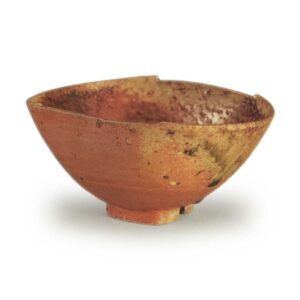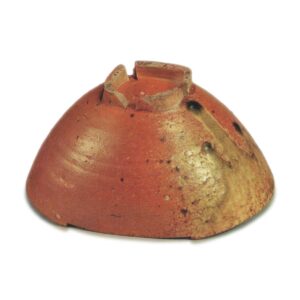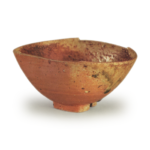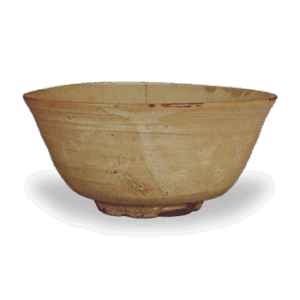

Height: 7.3cm
Diameter: 11.7-14.2cm
Outer diameter of foot ring: 4.3-4.6cm
Height of foot ring: 0.9cm
This is a famous tea bowl in the Enshu-kirigata style, or so-called Enshu-style, and in the “Enshu-kura-cho” (a book of tea bowls owned by Enshu) it is described as
Hanakitsu Shigaraki Hakusouko-kou (poem) Fukuro Ezo-nishiki
and also in the ‘Fushimiya Diary’ with a postscript dated 1790,
Hana-Tachibana Shigaraki Enshu-yoshi, made of clay, yellow Seto-like, with a yellowish-brown glaze inside the tea container, with a glaze on the outside, with a little stone-like pattern, thinly made. Black scratchings, gold powder, inside the lid, poem…
and also in the “Kushinroku” (Record of Hard Work) by the Meiji-era dealer and bookseller Ryoun,
Hana-Tachibana Shigaraki brush wash, Soho-ko liked. I think of the past, and I think of what I would do if there were no Hana-Tachibana. In red, now Akaboshi.
This suggests that it was known among tea ceremony masters as a Shigaraki tea bowl in the shape of a brush used for cleaning brushes, which was popular with Enshu. The legend that it was popular with Enshu is undeniable when you see its strong, yet elegant shape.
The mouth is square with a long side, and a single cut is made in the rim of the long side. The foot is also square, matching the shape of the rim on all four sides, and a cut is made in one corner and the middle of two sides, creating a kind of split foot.
The inside and outside of the bowl are covered in a lustrous glassy glaze, but the outside has three streaks of glaze running down it, while the inside is thickly glazed in the middle, creating a beautiful glassy effect as the word “vidro” suggests. The thinly glazed areas are a light green, while the thickly glazed areas are a deep green. The unglazed areas are burnt red, and the contrast between the green of the glaze and the red of the unglazed areas is vivid, making this deliberately stylish teacup even more attractive.
The hard, tightly-fired texture is closer to Iga ware than to Shigaraki ware, and is completely different from the so-called Sotatsu Shigaraki.
The thick brown tea stains around the rim also add to the visual effect.
Incidentally, if it was made during the Enshu period, it is thought to have been made around the end of the Kan’ei era to the Shoho era, and the fact that it is shaped like a brush washing stand shows the literary taste typical of Enshu, doesn’t it? This is a unique light brown tea bowl.
The inside of the lid of the box, which is coated with a black scraped finish, has the words “Hanatachibana” (Flowers are flowers) written in gold powder, and the inside of the lid of the box, which is coated with a tame-nuri finish, has the words “Mukashi wo ha hanatachibana no nakari se ha nani ni tsukete ka omoidamashi . The calligrapher was Kobori Enshu, and the waka poem that became the inscription was written by Omi Takatoyo in the summer section of the Goshuishu anthology.
The origin of the scroll after Enshu is unknown, but it is recorded in the notebook of Fushimiya Jinemon in the late Edo period, so it must have been owned by a considerable number of tea ceremony enthusiasts at the time. In the Meiji era, it became the property of Akaboshi Yanosuke of Tokyo, and in 1917, at the first auction of the Akaboshi family, it was sold to Ueno Yokichi of Kyoto for 17,000 yen. In 1925, at the auction of Ueno Yokichi’s belongings, it became the property of Fujita Tokujiro of Osaka.








